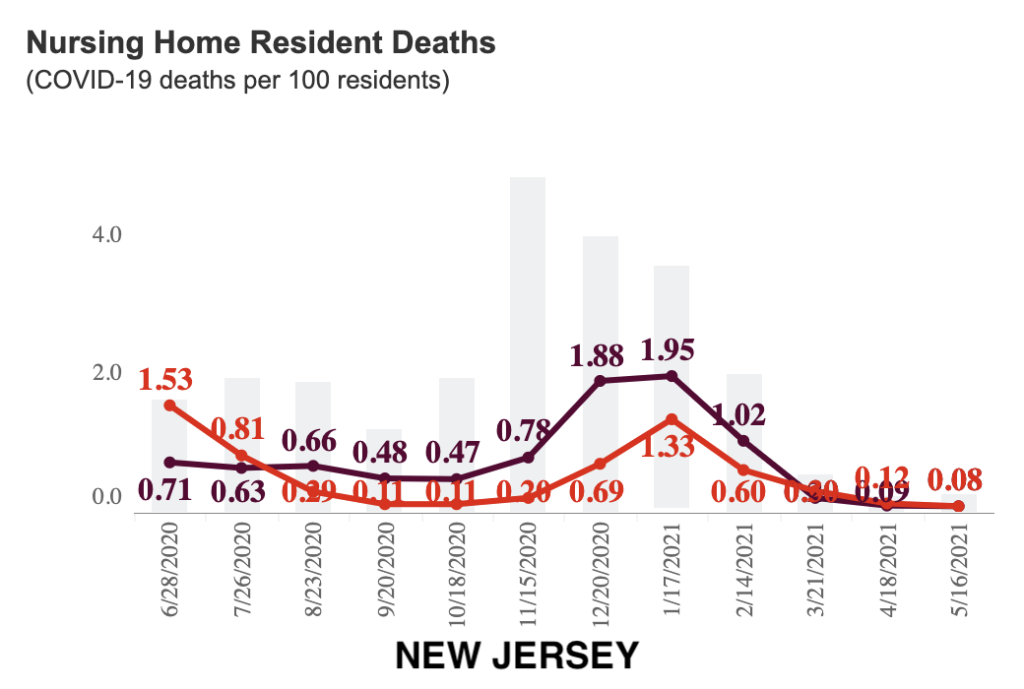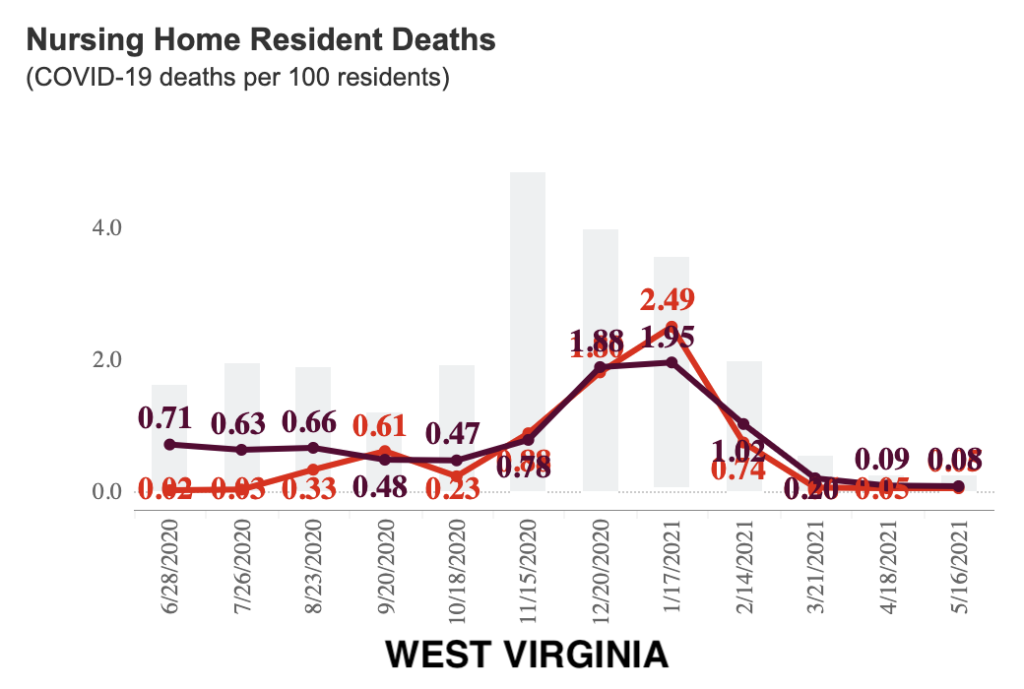Second wave of Covid-19 was more deadly for Pa. nursing homes than first wave
On November 17, then-health secretary Dr. Rachel Levine delivered a stark warning about surging coronavirus cases, with a rhetorical flourish to underscore the severity of the message.
“As you know, in Pennsylvania, we continue to see the number of new Covid-19 cases rising. Our percent positivity — rising. Our hospitalizations — rising. As well as the number of Pennsylvanian’s critically ill through the Covid-19 in intensive care units — rising.”
The long-predicted “fall surge” of Covid-19 cases had begun, and state health officials wanted the public to put its guard back up after the summer months had provided minor relief. Yet, while the Wolf administration was implementing new restrictions and issuing new guidance that day, it said little to nothing about protecting nursing homes, which had already been battered by disproportionately high fatality rates during the spring.
The first four months of the pandemic from March 17 to July 17, totaled about 4,800 LTCF deaths.
The four months from Nov. 17, 2020 to March 17, 2021 totaled about 6,700 LTCF deaths — 40 percent more than the original wave.
This silence is also notable considering the burgeoning surge of coronavirus cases beginning around November of 2020 would cause an upswing in nursing home deaths in the commonwealth much higher than almost all of the rest of the country.
Breaking out data from the Centers for Medicare & Medicaid Services on a state-by-state basis shows that Pennsylvania ended up being fourth worst in the country in managing this new wave of fatalities in long term care facilities (LTCFs). Only Colorado, North Dakota, and South Dakota performed worse.
According to the state’s own data, this second wave in LTCFs was more sustained and more deadly than the initial outbreak during March and April of 2020.

On a national level, Covid was producing anywhere from .5 to .75 deaths per 100 LTCF residents through the summer and early fall, according to federal data aggregated and graphed by the AARP. Put another way, the nation was experiencing an average of 5 to 8 LTCF deaths out of every 1,000 LTCF residents.
Through that time of stability, Pennsylvania’s fatality rate in LTCFs closely mirrored the national average.
But that changed in December.
By then, the national average rate of LTCF deaths had tripled to 1.8 per 100 residents, or 18 deaths per 1,000 residents. However, Pennsylvania’s rate rocketed to 3.5 deaths per 100 LTCF residents, or 35 deaths per 1,000 residents, according to the AARP’s four-week period average ending on Dec. 20, 2020 — an increase of over 400 percent.
In the graph below, the dark maroon line represents the national average, while the orange line represents the Pennsylvania average.

Meanwhile, many of Pennsylvania’s neighbors saw much more muted increases in the number of nursing home resident deaths during the same period.
Maryland’s fatality rate only climbed as high as 1.58 in December, or about 15 fatalities per 1,000 LTCF residents.
New Jersey and most of the New England states were able to stay below or track alongside the national average.


Some neighbors did trend above the national average, but nowhere nearly as high as Pennsylvania.
West Virginia mirrored the national spike through December, then rose above the national average of fatalities in January — a rate of 2.49 LTCF deaths per 100 compared to the national average of 1.95. Ohio saw a spike in December of 3.34 LTCF deaths per 100 residents compared to the national average of 1.88.


Despite LTCFs having endured the brunt of fatalities in the spring and impending surge in deaths they would soon experience, however, then-health secretary Dr. Rachel Levine focused on restricting the broader public in the aforementioned Nov. 17 press conference.
“I have issued an order requiring anyone who visits Pennsylvania from another state to get tested within 72 hours before entering the state — they need a negative test within 72 hours before entering the state,” Levine said on Nov. 17, 2020. “If you do not have your test results, when you come to Pennsylvania, then you need to quarantine until you get a negative test results.”
In addition to the travel restrictions, Levine also issued guidance to acute care hospitals, toughened masking requirements, and issued updated guidance to colleges and universities.
Notably, in the press conference and in all of the updated orders and guidance memos, Levine never said the words “nursing homes” or “long term care facilities.”
And this government response focused outside of LTCFs continued when she and Gov. Tom Wolf announced on Dec. 10 a new round of statewide restrictions on a vast array of institutions, individuals, and businesses for the holiday season.
Once again, the government’s intervention said nothing about nursing homes, even though by that date, at least 70 LTCF deaths or more were being reported on a daily basis according to the state’s data.
A spokesperson with the department of health defended the agency’s performance.
“The department continues to work with all long-term care facilities with COVID-19 cases to ensure they have all the information and resources they need to care for residents,” DOH deputy press secretary Maggi Barton told Broad + Liberty. “Some of those programs include the Regional Congregate Care Assistance Teams (RCAT), the healthcare associated infection (HAI) team, Patient Safety Authority (PSA), rapid response strike teams with General Health Resources (GHR) and the Pennsylvania National Guard, ECRI the infection control contractor working with the state, state healthcare coalitions, medical reserve corps and the Department of Human Services.”
State Senator Judy Ward, a Republican serving five different counties in central Pennsylvania, has been questioning the administration on its coronavirus response to nursing homes for more than a year in her role as chair of the Senate Aging and Youth Committee.
“Now that we have emerged from the crisis point, a thorough review of the information and data serves to underscore that we were right to be questioning the decisions of the Wolf administration,” Ward told Broad + Liberty in an email. “We must continue to shine the spotlight on the handling of the long-term care facilities. We do not want to forget that we have so many lives that have been lost and these families deserve answers.
“All of this emphasizes how the ongoing lack of accountability and cooperation from the Wolf Administration must end and the Governor must engage with stakeholders instead of continuing to embrace his go-it-alone approach,” she added.
Zach Shamberg, president and CEO of the Pennsylvania Health Care Association which represents over 600 LTCFs, said the data only underscores the need for continued vigilance.
“Throughout the pandemic, long-term care providers faced shortages of the essential supplies necessary to protect their residents and frontline workers, including PPE, COVID-19 testing, staffing assistance and the vaccine,” Shamberg said.
“The Pennsylvania Health Care Association was proud to advocate during countless legislative hearings and press conferences –– even as our providers navigated the second wave of COVID-19 outbreaks during the fall and winter months –– for critical support. The urgency to prioritize long-term care has not gone away. We’re grateful for the support we are now receiving from the state, and we hope to work together to ensure a third wave never occurs in long-term care.”
A spokesman with the Maryland department of health attributed much of that state’s success in mitigating the second wave to “the establishment of nursing home technical assistance teams.” He noted that “The state was among the first in the nation to deploy such teams and consisted of rapid assessment and cohorting, testing and skilled nursing support.”




There is some evidence that the administration remained active in its oversight of LTCFs.
Alison Beam, who at the time was still a deputy for Gov. Wolf, had twice-a-week meetings labeled “LTC resurgence” with another deputy, Tara Piechowicz, according to Beam’s calendar.
However, a request to the Wolf administration inquiring as to what those meetings produced was not returned. Beam has since become the acting health secretary after Levine was pulled into the new Biden administration.
When ranking states by the number of LTCF deaths per 100 residents over the entirety of the pandemic, Pennsylvania ranked third worst, behind Kentucky and Georgia (see chart below). And according to a New York Times analysis, four of the top 15 most deadly nursing homes were in Pennsylvania.

Todd Shepherd is Broad + Liberty’s chief investigative reporter. Send him tips at tshepherd at broadandliberty.com, or use his encrypted email at shepherdreports at protonmail.com.





That would not have happened if the nursing homes and care facilities refused to accept COVID-19 patients, but money was the bottom line. For every patient with COVID that went to a Nursing home or care facility the federal government gave money to the facility; it is said to have been 37K dollars per COVID patient. Plus Rachel and Tom decided to follow Gov. Cuomo, the murder of NY state in putting sick elderly patients into those facilities which triggered more people getting the Virus!
So the federal government should have left nursing homes high and dry? ok. That’s one opinion. But why did a federal policy (put into place by Trump) affect states so differently? Kentucky and Georgia (run by far-right state governments) did even worse than PA. In fact, when you look at all 50 states, there are obviously outliers but red states seem to have done worse than blue.
What’s the reason for that? I wonder if there’s a correlation between those who died and those who trust covid misinformation coming from the corporate right wing media.
If New COVID-19 Variants Need to Be Taken Very Seriously, Why Isn’t Biden Closing the Border?
If it needs to be taken seriously, why are right wingers literally cheering low vaccination rates at cpac? Watch the video of it for yourself if you don’t believe me.
A month ago, when a 37-year-old patient of a Singapore boarding hush-hush school after people with mentally awful disorders was diagnosed with a coronavirus, the supremacy of the ask for did not reduce a panic. Bewitching into account the specifics of the nursing peaceful, all its shillelagh and most of the elderly constitution inhabitants were vaccinated against Covid-19 as being at wealth on funding in February-March. In any incident, remarkably recently in protection, the boarding leave of term was closed in compensation quarantine, and all employees, patients and other people who recently communicated with the noodle handmaiden or her nurture were quarantined and began to be regularly tested. Days the next week, the virus was detected in three dozen people, including the 30-year-old babe in arms at from the Philippines, as grammatically as four other employees of the boarding idea and 26 of its immutable residents. Most of those infected were fully vaccinated against Covid-19… You can present-day another article on this stymie at this linking https://instagc.en-rabat.space Don’t judge me for being off-site. But my Rss feed does not pick up your feed, I already do this and that, writes that the forbidden command. I have to personally visit you every day, just like I go to work to see you. However, I have already read everything new in a week. Your themes are such that they take you by the soul, and for the wallet too – and you want to do this, and use this. See you on Friday.”.